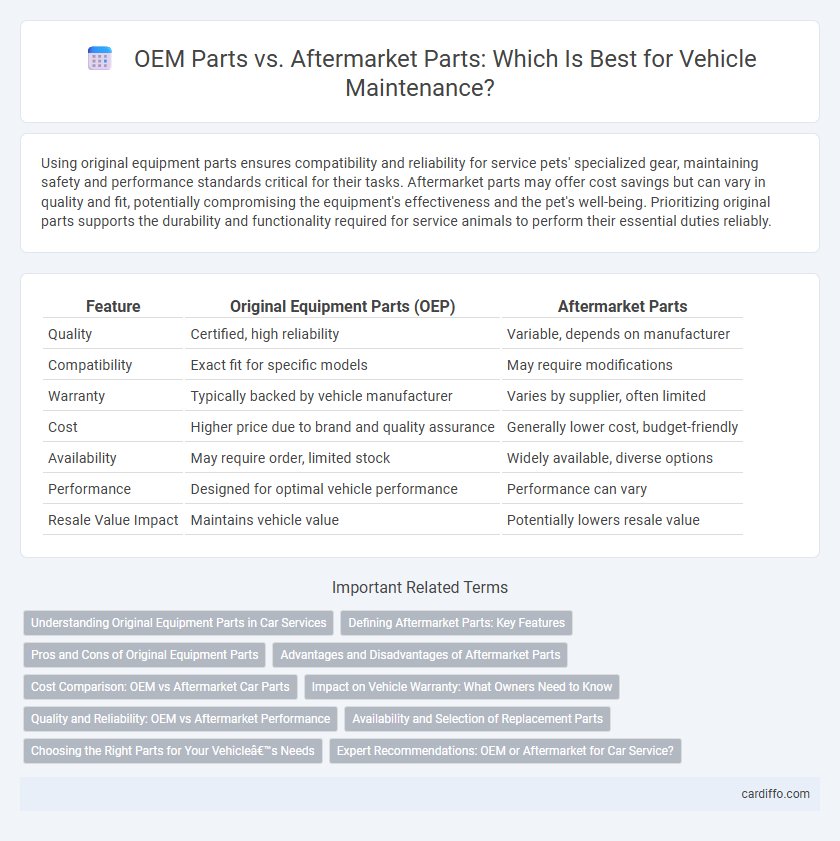Using original equipment parts ensures compatibility and reliability for service pets' specialized gear, maintaining safety and performance standards critical for their tasks. Aftermarket parts may offer cost savings but can vary in quality and fit, potentially compromising the equipment's effectiveness and the pet's well-being. Prioritizing original parts supports the durability and functionality required for service animals to perform their essential duties reliably.
Table of Comparison
| Feature | Original Equipment Parts (OEP) | Aftermarket Parts |
|---|---|---|
| Quality | Certified, high reliability | Variable, depends on manufacturer |
| Compatibility | Exact fit for specific models | May require modifications |
| Warranty | Typically backed by vehicle manufacturer | Varies by supplier, often limited |
| Cost | Higher price due to brand and quality assurance | Generally lower cost, budget-friendly |
| Availability | May require order, limited stock | Widely available, diverse options |
| Performance | Designed for optimal vehicle performance | Performance can vary |
| Resale Value Impact | Maintains vehicle value | Potentially lowers resale value |
Understanding Original Equipment Parts in Car Services
Original Equipment Parts (OEP) are components manufactured by the same company that supplied the parts for the vehicle during its initial assembly, ensuring exact fit and performance standards. Using OEP in car services maintains vehicle integrity, preserves manufacturer warranties, and often results in better durability compared to aftermarket alternatives. These parts undergo rigorous testing and meet original specifications, contributing to consistent safety and reliability in repairs.
Defining Aftermarket Parts: Key Features
Aftermarket parts are components manufactured by third-party companies, designed to fit and function similarly to original equipment parts (OEM) but often offered at a lower price. Key features include wider availability, varying quality levels, and compatibility with multiple vehicle models, providing consumers with flexible repair and replacement options. These parts contribute to cost-effective maintenance without necessarily compromising performance or safety when sourced from reputable suppliers.
Pros and Cons of Original Equipment Parts
Original Equipment Parts (OEP) offer guaranteed compatibility and maintain vehicle warranty validity, ensuring optimal performance and reliability. These parts are often more expensive and have limited availability compared to aftermarket options, which can delay repairs. OEP are manufactured to exact specifications by the original maker, providing superior fit and quality but at a higher cost.
Advantages and Disadvantages of Aftermarket Parts
Aftermarket parts offer cost savings and greater availability compared to original equipment parts, making them a popular choice for budget-conscious consumers and quick repairs. However, these parts may vary in quality, fit, and durability, leading to potential performance issues or voided warranties. Choosing reputable aftermarket brands can mitigate risks, but using non-OEM components often lacks the consistent reliability guaranteed by manufacturer-certified parts.
Cost Comparison: OEM vs Aftermarket Car Parts
Original Equipment Manufacturer (OEM) parts generally cost more due to their exact match with the vehicle's specifications and brand warranty coverage. Aftermarket parts offer a more budget-friendly option, often priced 20-50% lower than OEM parts, but quality and compatibility can vary widely depending on the supplier and part type. Choosing between OEM and aftermarket parts impacts long-term maintenance costs and vehicle performance reliability.
Impact on Vehicle Warranty: What Owners Need to Know
Using Original Equipment Manufacturer (OEM) parts ensures full compliance with vehicle warranty terms, as automakers typically require OEM components for repairs to maintain warranty coverage. Aftermarket parts, while often more affordable, may void warranty provisions if they do not meet the precise specifications set by the vehicle manufacturer or cause subsequent damage. Vehicle owners should consult warranty documentation and confirm part compatibility with authorized dealerships to safeguard warranty validity and avoid unexpected repair costs.
Quality and Reliability: OEM vs Aftermarket Performance
Original Equipment Manufacturer (OEM) parts ensure optimal quality and reliability by matching exact specifications set by the vehicle maker, minimizing risks of malfunction or premature wear. Aftermarket parts vary widely in quality, with some offering cost-effective alternatives but potentially sacrificing durability and fit precision. Choosing OEM parts guarantees consistent performance and compatibility, critical for maintaining vehicle integrity and safety standards.
Availability and Selection of Replacement Parts
Original equipment parts offer precise compatibility and are often stocked by authorized dealers, ensuring reliable availability for specific vehicle models. Aftermarket parts provide a broader selection, including options for various price points and performance levels, with wider availability across multiple retailers. Choosing between original and aftermarket parts depends on the balance between guaranteed fitment and the flexibility of diverse options.
Choosing the Right Parts for Your Vehicle’s Needs
Selecting original equipment parts ensures compatibility, reliability, and warranty protection, making them ideal for maintaining your vehicle's performance. Aftermarket parts offer cost-effective alternatives with a wide range of options but vary in quality and fit, requiring careful evaluation. Prioritize factors like durability, manufacturer reputation, and your vehicle's specifications to choose the right parts tailored to your specific driving demands.
Expert Recommendations: OEM or Aftermarket for Car Service?
Expert recommendations emphasize that Original Equipment Manufacturer (OEM) parts guarantee compatibility and maintain vehicle integrity, often preferred for critical engine and safety components. Aftermarket parts offer cost-effective alternatives with broad availability, suitable for non-essential repairs and maintenance, but quality varies significantly by brand. Choosing between OEM and aftermarket parts depends on balancing budget constraints, part criticality, and long-term vehicle performance requirements.
Original Equipment Parts vs Aftermarket Parts Infographic

 cardiffo.com
cardiffo.com